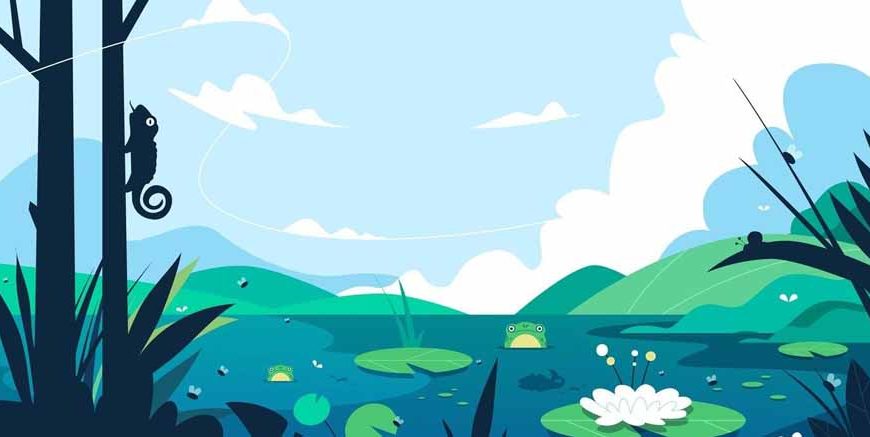‘Still Water’
One of the first thoughts that comes to mind, when one hears the word ‘Pond’.
And yet, it’s a place that’s ‘Bristling with Life!’
It’s true. What we largely take to be a body of placid, unmoving water, is actually an environment that is host to many different varieties of living beings!
In other words, the ‘Pond Ecosystem’.
In this blog, you will learn all about What is a Pond Ecosystem. From understanding the Function of a Pond Ecosystem to deciphering the different Types of Pond Ecosystems, you will learn all there is to know about that Pond Ecosystem. Start off your journey, by taking a Deep Dive into that Pond… No wait, Pond Ecosystem!
Table of Contents
- The Pond Ecosystem: A Closer Look at What is a Pond Ecosystem
- Unraveling The Structure of a Pond Ecosystem
- Classification of a Pond Ecosystem: Decoding the Types of a Pond Ecosystem
- Function of a Pond Ecosystem
The Pond Ecosystem: A Closer Look at What is a Pond Ecosystem
A Pond Ecosystem is a Freshwater Ecosystem that consists of a vast array of Aquatic Animals and Plants that interact with each other and the surrounding Aquatic Environment.
Note: The Pond Ecosystem can be either ‘Permanent’ or ‘Temporary’.
To understand a Pond Ecosystem better, it would be prudent to delve into the Structure of a Pond Ecosystem. The next section will help us understand just that.
Unraveling The Structure of a Pond Ecosystem
When speaking of the Structure of a Pond Ecosystem, one refers to the ‘Abiotic’ and ‘Biotic’ components it is composed of.
- Abiotic Components
- Water
- Sunlight
- Oxygen
- Temperature
- Essential Nutrients
- Biotic Components
- Producers
- Consumers
- Decomposers
These include several Basic components of a Pond Ecosystem, like the following.
The primary component, it serves as the medium for the various metabolic processes of the organisms within it.
Essential for that vital process of Photosynthesis!
Those aerobic organisms in the water all need this, like we on land do too!
A key factor that influences the metabolic rate of aquatic organisms.
Nutrients like Nitrogen and Phosphorus, are required by those aquatic organisms for their healthy growth!
These are broadly classified into Producers, Consumers and Decomposers
These include the Photosynthetic Bacteria and Green Plants that manufacture essential nutrients like carbohydrates and proteins, using solar energy.
Examples of Producers: Water Lilies, Reeds.
These include all the Herbivores, Carnivores and Omnivores in a pond. As their ‘type’ name suggests, their primary function is ‘consuming’!
Examples of Consumers: Frogs, Larger Fish, Dragonflies
These perform the function of breaking down dead organic matter and recycling the nutrients back into the ecosystem.
Examples of Decomposers: Fungi, Bacteria
Classification of a Pond Ecosystem: Decoding the Types of a Pond Ecosystem
The Classification of a Pond Ecosystem helps us garner a keener understanding of the various ‘Types’ of a Pond Ecosystem. Like the following.
- Freshwater Pond Ecosystem
- Garden Ponds
- Salt Pond Ecosystems
- Vernal Ponds
- Mountain Pond Ecosystems
These are the pond ecosystems that are typically created thanks to a steady flow of rainfall. They serve as home to many crustaceans, amphibians and reptiles.
Note: These can also be formed when river water is diverted into a large depression.
These refer to those ponds that are created by humans. Usually closed systems, they are home to several plant and animal species from around the world.
Usually formed as a result of waterlogging, these pond ecosystems are usually formed near the sea.
Note: Because they contain ‘brackish’ water, they can also serve as home to sea animals and plants.
Also known as ‘ephemeral’ ponds, these are ponds of a ‘seasonal’ nature. Plenty of species of animals like salamanders and frogs, depend on them for their survival.
Cool Fact: These are formed in depressions in the ground, but only when the rainfall is at its peak.
As the name suggests, these are usually found in mountainous areas. Typically, due to the melting of snow and rock-shifting.
Cool Fact: These are home to some of the most endangered species of aquatic animals!
Function of a Pond Ecosystem
The Functions of a Pond Ecosystem are far more diverse than you might have imagined. Presenting the key Functions of a Pond Ecosystem.
- Providing a Home to Aquatic Organisms
- Water Filtration
- The Production of Oxygen
- The Pond Ecosystem Food Chain
- The Cycling of Nutrients
Every organism needs a place to call ‘home’, right? A home that they can rely on for Shelter, Feeding and many other invaluable functions!
Those ‘Pollutants’ in the pond water are absorbed by those aquatic microorganisms and plants, and then broken down. This goes a long way in improving the Water Quality!
What those aquatic plants do best, is to produce that invaluable ‘Oxygen’ via the process of Photosynthesis. Needless to say, this oxygen is essential to the survival of aquatic animals like fish.
There exists an’ Interconnected’ Food Web that is based upon the Feeding Relationships between the living organisms in ponds. For instance, those aquatic plants are consumed by the herbivores, who are in turn consumed by the predators.
Note: The Pond Ecosystem Food Chain is more important than one might think. It is actually most essential for the mere ‘survival’ of the organisms in a pond.
As we touched upon in the section above, those ‘decomposers’ break down those dead plants and animals into nutrients like Nitrogen and Phosphorus. These vital nutrients are then released back into the ecosystem, to those algae and aquatic plants. In a nutshell, this forms the very ‘backbone’ of that Pond Ecosystem Food Chain mentioned above!
Broadly speaking, a Pond Ecosystem is not only beneficial for the organisms that live within it, but for the Environment in general. Use the information outlined herein, to enlighten your kids today about the wonderful phenomena that are Pond Ecosystems!
















